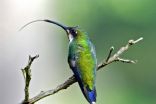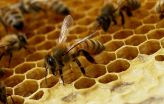New research shows that hummingbird tongue is really a tiny pump
UConn biologists and an expert on fluid mechanics join forces to prove a point
2015-08-19
(Press-News.org) In a paper titled Hummingbird tongues are elastic micropumps which appears in the August 19 issue of Proceedings of the Royal Society B, Alejandro Rico Guevara and Margaret Rubega from the Department of Ecology and Evolutionary Biology and Tai-Hsi Fan from the School of Engineering, say that fluid is actually drawn into the tongue by the elastic expansion of the tongues grooves after they are squeezed flat by the beak.
Their data shows that fifty years of research describing how hummingbirds and floral nectar have coevolved will have to be reconsidered.
What is actually taking place, the researcher report, is that during the offloading of the nectar inside the bill, hummingbirds compress their tongues upon extrusion. The compressed tongue remains flattened until it contacts the nectar surface, after which the tongue reshapes, filling entirely with nectar.
The expansive filling mechanism uses the elastic recovery properties of the groove walls to load nectar on the tongue in an order of magnitude that allows the hummingbirds to extract nectar at higher rates than are predicted by capillarity-based foraging models.
Observations and measurements were taken from seven countries throughout the Americas where free-living, never handled hummingbirds were feeding at modified transparent feeders simulating nectar volumes and concentrations of hummingbird pollenated flowers. The researchers measured 96 foraging bouts of 32 focal birds belonging to 18 species from seven out the nine main hummingbird clads.
In the hundreds of licks studied, the researchers observed capillarity only once, acting on a single tongue groove. This occurred when, during initial tongue protrusion, one of the groove tips adhered to the feeder wall before the tip reached the surface of the nectar pool and the groove tip bent as the tongue continued to move forward.
Thanks to this unusual incident, high speed video captured one of the two grooves being filled by expansive filling, as usual, while the other was being filled by capillarity. This offered an opportunity to directly compare the two mechanism and measurements clearly demonstrated that the capillary filling rate was significantly slower than expansive filling.
Rico-Guevara says, "Our research shows how hummingbirds really drink and provides the first mathematical tools to accurately model their energy intake, which in turn informs our understanding of their foraging decisions and ecology."
INFORMATION:
Research Contacts:
Alejandro Rico-Guevara: Alejandro.rico@uconn.edu
Department of Ecology & Evolutionary Biology
Margaret Rubega: Margaret.rubega@uconn.edu (860) 486-4502
Department of Ecology & Evolutionary Biology
Tai-His Fan: thfan@engr.uconn.edu (860) 486-0553
Department of Mechanical Engineering
[Attachments] See images for this press release:

ELSE PRESS RELEASES FROM THIS DATE:
2015-08-19
Researchers from North Carolina State University have developed an efficient algorithm that can interpret the wheezing of patients with breathing difficulties to give medical providers information about what's happening in the lungs. The research is part of a larger, ongoing project to develop wearable smart medical sensors for monitoring, collecting and interpreting personal health data.
The work was done by Saba Emrani and Hamid Krim, researchers in the National Science Foundation Nanosystems Engineering Research Center for Advanced Self-Powered Systems of Integrated ...
2015-08-19
CHICAGO --- Polycystic ovary syndrome (PCOS) has been passed down in many families for generations -- causing reproductive and metabolic health problems for millions of women around the world. Yet, its cause remains unknown despite more than 80 years of research since the disorder was first described in 1935.
A new Northwestern Medicine genome-wide association study of PCOS -- the first of its kind to focus on women of European ancestry -- has provided important new insights into the underlying biology of the disorder.
Using the DNA of thousands of women and genotyping ...
2015-08-19
LAWRENCE -- Compulsory schooling laws instituted in the late 1800s and early 1900s caused more people in Northern states to marry people at their same education level and race, possibly contributing to economic inequality, according to a University of Kansas researcher's study.
Emily Rauscher, a KU assistant professor of Sociology, found no increase in assortative mating in Southern states as a result of the laws, suggesting the influence of educational expansion on marital sorting depends on context.
"It's difficult to know why the compulsory laws had different effects ...
2015-08-19
Solo travellers don't go alone because they have to, they do it because they want to, a new Queensland University of Technology study has found.
Professor Constanza (Connie) Bianchi, from QUT Business School, said there were a growing number of people who preferred to travel alone, despite having family and friends.
She said solo travellers were choosing freedom, uncompromised fun and meeting new people over the desire to have a companion to share their experiences.
In a study published in the International Journal of Tourism Research, Professor Bianchi looked at ...
2015-08-19
This news release is available in Japanese.
An international research team has some good news for the struggling honeybee, and the millions of people who depend on them to pollinate crops and other plants.
These valuable pollinators have faced widespread colony losses over the past decade, largely due to the spread of a predatory mite called Varroa destructor. But the bees might not be in as dire a state as it seems, according to research recently published in Nature Communications.
Researchers found a population of wild bees from around Ithaca, New York, which ...
2015-08-19
Current international disease surveillance systems are mainly based on reports made by doctors after treatment of infected patients. As a consequence, disease-causing microorganisms and resistance bacteria have time to spread and make large population groups sick before they are detected.
There is currently only very limited information about the global occurrence and transfer of antimicrobial resistance and infectious diseases.
Researchers at the National Food Institute and DTU Systems Biology are working to develop faster methods to detect and respond to outbreaks ...
2015-08-19
Scientists at VIB and KU Leuven have shown that blocking the PHD1 oxygen sensor hinders the activation of p53, a transcription factor that aids colorectal cancer (CRC) cells in repairing themselves and thus resisting chemotherapy. Chemotherapy resistance remains a major clinical issue in the treatment of CRC. These findings indicate that PHD1 inhibition may have valuable therapeutic potential. The study was published in the leading medical journal EMBO Molecular Medicine, which features molecular biology-driven research.
Chemotherapy remains the most widely used cancer ...
2015-08-19
Safinamide (trade name: Xadago) has been available since February 2015 as add-on therapy for the treatment of mid- to late-stage Parkinson disease in adults. In combination with levodopa alone or together with other Parkinson disease medicinal products, this monoamine oxidase (MAO-B) inhibitor is used to help restore dopamine levels in the brain. The German Institute for Quality and Efficiency in Health Care (IQWiG) examined in a dossier assessment whether this drug offers an added benefit over the appropriate comparator therapy.
Such an added benefit cannot be derived ...
2015-08-19
The study, by scientists at the University of St Andrews, shows that simple increases in a man's height and age automatically makes them appear more dominant.
The research, published today (Wednesday 19 August 2015) by the SAGE journal 'Perception', sheds light on why Hollywood directors might choose certain actors to play leading roles.
The study was carried out by Carlota Batres, Daniel Re, and Professor David Perrett of the Perception Lab at the University's School of Psychology & Neuroscience.
Carlota and her team used computer graphic manipulations to make subtle ...
2015-08-19
The older the clinician, the more likely they are to think playing video games leads to violent behavior, according to new research published in Computers in Human Behavior.
Psychology professor Dr. Christopher Ferguson, author of the study from Stetson University, US, says his findings go some way to explaining why people have different opinions about the effect of video games and suggests many of the reasons come down to generational issues. For parents, one way to close this gap is speaking to children and testing out the games themselves.
As long as video games ...
LAST 30 PRESS RELEASES:
[Press-News.org] New research shows that hummingbird tongue is really a tiny pump
UConn biologists and an expert on fluid mechanics join forces to prove a point

